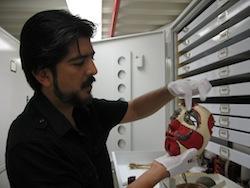
Alessandro Questa
B.A. National School of Anthropology and History 2004
M.A. National Autonomous University of Mexico 2010
Specialties
fieldwork with different groups in Mesoamerica (Mexico). Currently working with Nawa of Puebla. Previous research on ritual kinship, shamanism, personhood and mythology. Currently interested in ritual dances, masking practices and material culture.
I studied Ethnology at the National School of Anthropology and History (ENAH) of Mexico, mainly because I enjoy learning from other people by living with them, which I guess defines me as an ethnographer. My first ethnographic experience was among the Warihó of the Sierra Tarahumara in northern Mexico attesting their social organization and cultural resilience under the extreme violence of drug trafficking. I later lived amongst the Pame (xi’oi) of Querétaro state for several months, working for a Mexican government agency (INI), to stimulate local history through oral memory workshops. Shortly afterwards I joined the National Institute of Anthropology and History (INAH) as a research assistant and remained there, linked to different research teams, for the next decade.
From 1999 to 2004 I studied the Otomí of central Mexico’s kinship, territoriality, migration and ritual. I wrote my BA thesis in Ethnology looking on their complex naming and territoriality systems based on kinship, oratory groups and ritual organization, graduating with Honors and receiving a National Honorific Mention (2004). Since 2006 I have done research among the Nawa in the mountains of Puebla, I have started to learn their language (Nahuatl) and wrote a couple of articles on them. Simultaneously, I coursed a two-year Masters degree in Social Anthropology at the National Autonomous University of Mexico (UNAM). The focus of my second thesis was on the Nawa ritual kinship relations with non-human entities. I graduated with Honors in 2010 and obtained my second National Honorific Mention (2010). Before arriving to UVA’s graduate program I worked for a year as chief curator for two small ethnographic exhibits on indigenous masks. All that is behind me now.
I am currently interested in continuing my work with Mexican indigenous groups –mainly Nawa- but also in connecting certain practices and ideas, deposited in ceremonial objects and animated through ritual performance, as a tool to think more broadly on common themes (history, transformation, subjectivization, ontology) relevant in the North American region. I am particularly interested in ritual masks and ritual dance associations across the Eastern mountain range (Sierra Madre Oriental) of Mexico and the possible scholarly comparison with other traditions in the continent. Recent experiences with Museum Anthropology at the Smithsonian Institution, have led me to become more and more interested about material culture and collections as a potent venue for asking these and other research questions.
• 2002: “Territorial fragmentations in an Otomi community” In Diario de Campo, No. 42, April. Pp.16-18. • 2003: “Our Caretaker. Power and ethnicity in a Nahua community in the Huasteca region” ALVAREZ, R.; QUESTA, A., in Mexico Indígena, Nueva Época, No. 3, January, Pp. 21-26, [ISSN 0185-058X]. • 2004: Saints, mountains and pilgrims in the State of Mexico In Dialogues with the territory, BARABAS, A. (Ed.), Scientific Essays, INAH / CONACULTA, Mexico, 231-277 [ISBN 970-35-0111-7]. • 2005: “The Otomi of Dongú: town, neighborhood and domestic celebrations”, In Parties for the Saints. Family and communal cult among the otomian and Nahua in the State of Mexico, CORTÉS, E. (ed.) Monographs, CONACULTA / INAH, Mexico, Pp. 91-116 [ISBN 968-03-0105-2]. • 2005: With God or with the Devil. Ethnicity in the State of Mexico, CORTÉS E. (Ed.), Scientific Essays, Conaculta / INAH, Mexico, Pp. 279-328 [ISBN 968-03-0112-5]. • 2006: Otomi from the northern state of Mexico and southern state of Queretaro, National Commission for the Development of Indigenous People (CDI), Mexico, [ISBN 970-953-078-2]. • 2008: “For every life several worlds. Notions of ritual kinship among the Nahua of Tepetzintla” In The Nahua world: kinship and rituality, ROBICHAUX, D.; MILLÁN, S. (Eds.), Supplement No. 47 Diario de Campo, March-April, Mexico, Pp. 41-51. • 2008: “The Devil went to hell when the Lord’s word arrived. Ethnic Catholicism and new religious options in the indigenous communities of the State of Mexico.” In Essays on religious plurality in the indigenous regions of Mexico, July (in press). • 2009: Communal organization and family chapel cult among the Otomi of Dongú, In III Coloquio Internacional Grupos Otopames, SERRANO, A. (Ed.), Volume II, Mexico. Pp. 181-223.